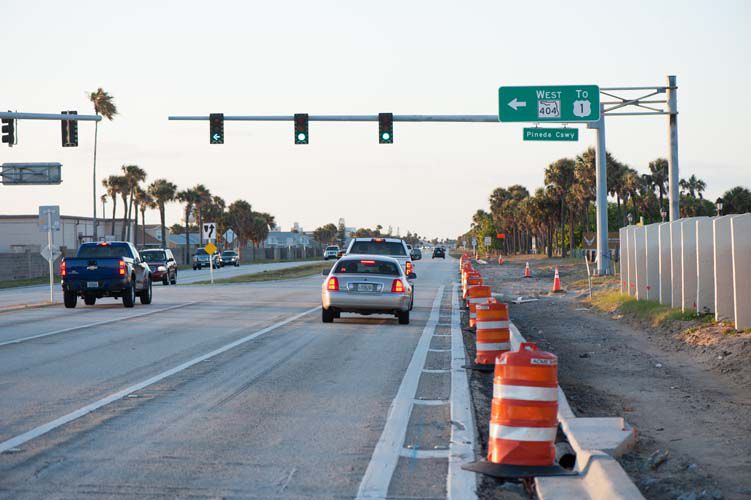
Officials hope the redesigned intersection at Highway A1A at Pineda Causeway will solve multiple problems, improve traffic flow and make both drivers and pedestrians safer.
Thanks to local input and listening ears at the Florida Department of Transportation, the northbound through lane was removed because it was a hazard to drivers trying to avoid the traffic light when cars exited the beach access located to the north. Sidewalks are being added to aid pedestrian traffic to and from the beach.
“The change was made to improve safely, as the through-lane ended abruptly at the park entry,” said Florida Department of Transportation public information specialist Jen Horton.
Perhaps as importantly, especially from a pedestrian point of view, the sidewalks are going to be extended on the east side of A1A to the Patrick Air Force Base beach access.
The revision to the overall resurfacing project came about as a request from the City of Satellite Beach and clears the way for the goal of a continuous sidewalk along SR A1A through Brevard County, said Satellite Beach City Manager Courtney Barker.
“Luckily DOT is looking at sidewalks and bike lanes as a necessity,’’ said Barker, who sits on the county technical advisory committee from the Space Coast Transportation Planning Organization.
As city manager, she inquired about the removal of the through lane. “We said take the through lane out because there is no purpose to it. They agreed,” she said. “They actually really don’t like the through lanes and are starting to take them out throughout the county.”
Satellite Beach is notorious for beachgoers and surfers darting across A1A, often barefoot, carrying surfboards and beach gear, in heavy traffic.
“Since we are on the beach, there are pedestrians and bicyclists everywhere,” Barker said. “Through lanes are very dangerous for those situations and Patrick AFB is trying to slow traffic down in those areas. That through lane didn’t do any favors to anyone.”
The response has been positive so far, according to the city. “The residents of the condos aren’t allowed to walk their dogs on the beach so were required to cross SR A1A to walk their dogs,” Barker said. “That’s a hardship for them so they are excited to sidewalks going in in front of their buildings.”
The completion of the project will leave only small sections on the west side of A1A without sidewalks.
The improvements show a new willingness on the part of DOT to make safety changes, said Georganna Gillette, Transportation Program Manager for the Space Coast Transportation Planning Organization. “The Pineda accommodates bicycles now so things have changed,” Gillette said.
“The way the DOT used to do things, they would just resurface the road unless there was a glaring safety issue,” Gillette said. “But they are going beyond and adding sidewalks and addressing safety issues.”
The adaptations in the project during construction also show a broader shift in philosophy at DOT, she said.
“They basically are looking at roadways in a context-sensitive way. They are looking at the nature of the corridor and what the land use is and the design of it. That is not the way the DOT has done things in the past,’’ she said.
Safety has always been a number one priority at DOT, Gillette said, but lately she’s seen a greater attention to detail. “When they go out and touch a roadway now they are really looking at it, the crash data and who is using the corridor,” she said. “They very much ask the municipalities that it runs through, because it’s their communities and they have the real information.”
In the end, taxpayers funding these expensive road projects get better results for their dollars.
“I think the DOT has recognized that continuous through lanes can be very hazardous for pedestrians and can cause vehicular accidents as well,” Gillette said. “They want to move traffic, but perhaps that is not the way to do it.”



